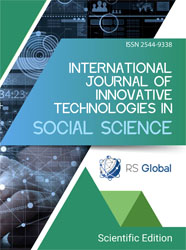CLINICAL AND PATHOPHYSIOLOGICAL SPECIFICITIES OF ATHEROSCLEROSIS IN PATIENTS WITH TYPE 2 DIABETES
Abstract
Research objectives: Type 2 diabetes mellitus significantly increases the risk of developing atherosclerosis and cardiovascular complications. Cardiovascular diseases are the leading cause of death in this patient population; however, diagnosis is often delayed due to the potential for atypical clinical presentation. The purpose of this review is to present the specific clinical and pathophysiological features of atherosclerosis in patients with type 2 diabetes mellitus, with particular emphasis on the distinct mechanisms of atherosclerotic development in these patients, as well as diagnostic and prognostic differences.
Key findings: In the course of type 2 diabetes mellitus, atherosclerosis develops against a background of chronic metabolic disturbances such as hyperglycemia, insulin resistance, dyslipidemia, and chronic inflammation. Patients often present with atypical or minimal symptoms, which complicates early diagnosis. Standard cardiovascular risk assessment tools may underestimate the actual threat in this group. Current research is exploring the use of novel biomarkers and imaging techniques to improve the precision of risk stratification.
Summary (conclusions): Atherosclerosis in type 2 diabetes mellitus is characterized by a distinct clinical and biological profile. Understanding these differences is essential for earlier diagnosis, more accurate risk assessment, and more effective cardiovascular prevention in this high-risk patient population.
References
Beckman, J. A., Creager, M. A., & Libby, P. (2002). Diabetes and atherosclerosis: Epidemiology, pathophysiology, and management. JAMA, 287(19), 2570–2581.
Verma, S., & Anderson, T. J. (2001). The ten most commonly asked questions about endothelial function in cardiology. Cardiology Review, 9(5), 250–252.
Sarkar, R., Meinberg, E. G., Stanley, J. C., Gordon, D., & Webb, R. C. (1996). Nitric oxide reversibly inhibits the migration of cultured vascular smooth muscle cells. Circulation Research, 78(2), 225–230.
Kubes, P., Suzuki, M., & Granger, D. N. (1991). Nitric oxide: An endogenous modulator of leukocyte adhesion. Proceedings of the National Academy of Sciences, 88(11), 4651–4655. https://doi.org/10.1073/pnas.88.11.4651
De Vriese, A. S., Verbeuren, T. J., Van de Voorde, J., Lameire, N. H., & Vanhoutte, P. M. (2000). Endothelial dysfunction in diabetes. British Journal of Pharmacology, 130(5), 963–974. https://doi.org/10.1038/sj.bjp.0703393
Hennes, M. M., O’Shaughnessy, I. M., Kelly, T. M., Osei, K., & O'Dorisio, T. M. (1996). Insulin-resistant lipolysis in abdominally obese hypertensive individuals. Hypertension, 28(1), 120–126. https://doi.org/10.1161/01.HYP.28.1.120
Inoguchi, T., Li, P., Umeda, F., Yu, H. Y., Kakimoto, M., Imamura, M., ... & Nawata, H. (2000). High glucose level and free fatty acid stimulate reactive oxygen species production through protein kinase C–dependent activation of NAD(P)H oxidase in cultured vascular cells. Diabetes, 49(11), 1939–1945. https://doi.org/10.2337/diabetes.49.11.1939
Hopfner, R. L., & Gopalakrishnan, V. (1999). Endothelin: Emerging role in diabetic vascular complications. Diabetologia, 42(11), 1383–1394. https://doi.org/10.1007/s001250051431
Quehenberger, P., Bierhaus, A., Fasching, P., Muellner, C., Klevesath, M., Riedmüller, G., ... & Nawroth, P. P. (2000). Endothelin 1 transcription is controlled by nuclear factor-kappaB in AGE-stimulated cultured endothelial cells. Diabetes, 49(9), 1561–1570. https://doi.org/10.2337/diabetes.49.9.1561
Achmad, T. H., Winterscheidt, A., Lindemann, C., & Rao, G. S. (1997). Oxidized low density lipoprotein acts on endothelial cells in culture to enhance endothelin secretion and monocyte migration. Methods and Findings in Experimental and Clinical Pharmacology, 19(3), 153–159. https://doi.org/10.1358/mf.1997.19.3.372759
Patricia, M. K., Kim, J. A., Harper, C. M., McKellar, D., & Simon, D. I. (1999). Lipoxygenase products increase monocyte adhesion to human aortic endothelial cells. Arteriosclerosis, Thrombosis, and Vascular Biology, 19(11), 2615–2622. https://doi.org/10.1161/01.ATV.19.11.2615
Freitas Lima, L. C., Braga, V. A., do Socorro de França Silva, M., Cruz, J. C., Sousa Santos, S. H., de Oliveira Monteiro, M. M., & Balarini, C. M. (2015). Adipokines, diabetes and atherosclerosis: An inflammatory association. Frontiers in Physiology, 6, 304. https://doi.org/10.3389/fphys.2015.00304
Lumeng, C. N., & Saltiel, A. R. (2011). Inflammatory links between obesity and metabolic disease. The Journal of Clinical Investigation, 121(6), 2111–2117. https://doi.org/10.1172/JCI57132
Son, S. M. (2007). Role of vascular reactive oxygen species in development of vascular abnormalities in diabetes. Diabetes Research and Clinical Practice, 77(3), S65–S70. https://doi.org/10.1016/j.diabres.2007.01.012
Rizvi, A. A. (2007). Inflammation markers as mediators of vasculo-endothelial dysfunction and atherosclerosis in the metabolic syndrome and type 2 diabetes. Chinese Medical Journal, 120(21), 1918–1924. https://doi.org/10.1097/00029330-200711010-00007
Brodeur, M. R., Bouvet, C., Bouchard, S., Moreau, S., Leblond, J., Deblois, D., & Marette, A. (2014). Reduction of advanced-glycation end products levels and inhibition of RAGE signaling decreases rat vascular calcification induced by diabetes. PLoS ONE, 9(1), e85922. https://doi.org/10.1371/journal.pone.0085922
Stabley, J. N., & Towler, D. A. (2017). Arterial calcification in diabetes mellitus: Preclinical models and translational implications. Arteriosclerosis, Thrombosis, and Vascular Biology, 37(2), 205–217. https://doi.org/10.1161/ATVBAHA.116.306258
Tintut, Y., Alfonso, Z., Saini, T., & Demer, L. L. (2000). Tumor necrosis factor-α promotes in vitro calcification of vascular cells via the cAMP pathway. Circulation, 102(21), 2636–2642. https://doi.org/10.1161/01.CIR.102.21.2636
Nadra, I., Mason, J. C., Philippidis, P., Florey, O., Smythe, C. D. W., McCarthy, G. M., ... & Haskard, D. O. (2005). Proinflammatory activation of macrophages by basic calcium phosphate crystals via protein kinase C and MAP kinase pathways: A vicious cycle of inflammation and arterial calcification? Circulation Research, 96(12), 1248–1256. https://doi.org/10.1161/01.RES.0000171451.88616.c2
Al-Aly, Z. (2007). Medial vascular calcification in diabetes mellitus and chronic kidney disease: The role of inflammation. Cardiovascular & Haematological Disorders – Drug Targets, 7(1), 1–6. https://doi.org/10.2174/187152907780059047
Rizzoni, D., & Agabiti Rosei, E. (2009). Small artery remodeling in diabetes mellitus. Nutrition, Metabolism and Cardiovascular Diseases, 19(8), 587–592. https://doi.org/10.1016/j.numecd.2009.03.011
Rizzoni, D., Porteri, E., Guelfi, D., Muiesan, M. L., Valentini, U., Cimino, A., ... & Agabiti Rosei, E. (2001). Structural alterations in subcutaneous small arteries of normotensive and hypertensive patients with non–insulin-dependent diabetes mellitus. Circulation, 103(9), 1238–1244. https://doi.org/10.1161/01.CIR.103.9.1238
Schofield, I., Malik, R., Izzard, A., Austin, C., & Heagerty, A. (2002). Vascular structural and functional changes in type 2 diabetes mellitus: Evidence for the roles of abnormal myogenic responsiveness and dyslipidemia. Circulation, 106(24), 3037–3043. https://doi.org/10.1161/01.CIR.0000041432.80615.A5
Sobol, A. B., & Watala, C. (2000). The role of platelets in diabetes-related vascular complications. Diabetes Research and Clinical Practice, 50(1), 1–16. https://doi.org/10.1016/S0168-8227(00)00160-1
El Haouari, M., & Rosado, J. A. (2008). Platelet signalling abnormalities in patients with type 2 diabetes mellitus: A review. Blood Cells, Molecules and Diseases, 41(1), 119–123. https://doi.org/10.1016/j.bcmd.2008.02.010
Winocour, P. D., Slater, A., Leach, A. G., & Brockbank, E. (1992). Decreased platelet membrane fluidity due to glycation or acetylation of membrane proteins. Thrombosis and Haemostasis, 68(11), 577–582. https://doi.org/10.1055/s-0038-1655876
Keating, F. K., Sobel, B. E., & Schneider, D. J. (2003). Effects of increased concentrations of glucose on platelet reactivity in healthy subjects and in patients with and without diabetes mellitus. The American Journal of Cardiology, 92(11), 1362–1365. https://doi.org/10.1016/j.amjcard.2003.08.028
Ferretti, G., Bacchetti, T., Rabini, R. A., Curatola, G., Delle Monache, F., & Mazzanti, L. (2002). Glycated low density lipoproteins modify platelet properties: A compositional and functional study. The Journal of Clinical Endocrinology & Metabolism, 87(5), 2180–2184. https://doi.org/10.1210/jcem.87.5.8444
Kessler, L., Drouin, P., & Pinget, M. (1998). Von Willebrand factor in diabetic angiopathy. Diabetes & Metabolism, 24(4), 327–336. https://doi.org/10.1016/S1262-3636(98)80046-1
Boden, G., & Rao, A. K. (2007). Effects of hyperglycemia and hyperinsulinemia on the tissue factor pathway of blood coagulation. Current Diabetes Reports, 7(3), 223–227. https://doi.org/10.1007/s11892-007-0035-1
Ängerud, K. H., Thylén, I., Sederholm Lawesson, S., Eliasson, M., Näslund, U., & Brulin, C. (2016). Symptoms and delay times during myocardial infarction in 694 patients with and without diabetes: An explorative cross-sectional study. BMC Cardiovascular Disorders, 16(1), 108. https://doi.org/10.1186/s12872-016-0282-7
Balcıoğlu, A. S., & Müderrisoğlu, H. (2015). Diabetes and cardiac autonomic neuropathy: Clinical manifestations, cardiovascular consequences, diagnosis and treatment. World Journal of Diabetes, 6(1), 80–91. https://doi.org/10.4239/wjd.v6.i1.80
Vinik, A. I., & Ziegler, D. (2007). Diabetic cardiovascular autonomic neuropathy. Circulation, 115(3), 387–397. https://doi.org/10.1161/CIRCULATIONAHA.106.634949
Berman, N., Jones, M. M., & De Coster, D. A. (2017). ‘Just like a normal pain’: What do people with diabetes mellitus experience when having a myocardial infarction? A qualitative study recruited from UK hospitals. BMJ Open, 7(9), e015736. https://doi.org/10.1136/bmjopen-2016-015736
Carson, A. P., Muntner, P., Kissela, B. M., Kleindorfer, D. O., Howard, V. J., Meschia, J. F., & Safford, M. M. (2012). Association of prediabetes and diabetes with stroke symptoms: The REasons for Geographic and Racial Differences in Stroke (REGARDS) study. Diabetes Care, 35(9), 1845–1852. https://doi.org/10.2337/dc12-0458
Jermendy, G. (2003). Clinical consequences of cardiovascular autonomic neuropathy in diabetic patients. Acta Diabetologica, 40(Suppl. 2), S370–S374. https://doi.org/10.1007/s00592-003-0122-y
Snarska, K., Kapica-Topczewska, K., Sawicka, J., Drozdowski, W., & Bachórzewska-Gajewska, H. (2010). Cukrzyca jako czynnik ryzyka udaru niedokrwiennego mózgu [Diabetes as a risk factor for ischemic stroke]. Endokrynologia, Otyłość i Zaburzenia Przemiany Materii, 6(2), 93–100. (DOI not available)
Rodriguez-Hernandez, A., Babici, D., Campbell, M., CarranzaReneteria, O., & Hammond, T. (2023). Hypoglycemic hemineglect: A stroke mimic. eNeurologicalSci, 30, 100444. https://doi.org/10.1016/j.ensci.2023.100444
Szczyrba, S., Kozera, G., Bieniaszewski, L., & Nyka, W. M. (2010). Neuropatia cukrzycowa – patogeneza, rozpoznawanie, zapobieganie, leczenie. In Forum Medycyny Rodzinnej, 4(5), 339–355. https://doi.org/10.26444/jpccr/109010
Mosenzon, O., et al. (2021). CAPTURE: A multinational, cross-sectional study of cardiovascular disease prevalence in adults with type 2 diabetes across 13 countries. Cardiovascular Diabetology, 20, 154. https://doi.org/10.1186/s12933-021-01344-0
Ma, C.-X., Ma, X.-N., Guan, C.-H., Li, Y.-D., Mauricio, D., & Fu, S.-B. (2022). Cardiovascular disease in type 2 diabetes mellitus: Progress toward personalized management. Cardiovascular Diabetology, 21(1), 74. https://doi.org/10.1186/s12933-022-01516-6
Einarson, T. R., Acs, A., Ludwig, C., & Panton, U. H. (2018). Prevalence of cardiovascular disease in type 2 diabetes: A systematic literature review of scientific evidence from across the world in 2007–2017. Cardiovascular Diabetology, 17, 83. https://doi.org/10.1186/s12933-018-0728-6
McGurnaghan, S., et al. (2018). Cardiovascular disease prevalence and risk factor prevalence in Type 2 diabetes: A contemporary analysis. Diabetic Medicine, 36(6), 718–725. https://doi.org/10.1111/dme.13825
Agarwal, G., & Singh, S. K. (2017). Arrhythmias in Type 2 Diabetes Mellitus. Indian Journal of Endocrinology and Metabolism, 21(5), 715–718. https://doi.org/10.4103/ijem.IJEM_448_16
Chow, E., et al. (2017). Cardiac autonomic regulation and repolarization during acute experimental hypoglycemia in type 2 diabetes. Diabetes, 66(5), 1322–1333. https://doi.org/10.2337/db16-1310
Andersen, A., et al. (2021). Associations of hypoglycemia, glycemic variability and risk of cardiac arrhythmias in insulin-treated patients with type 2 diabetes: A prospective, observational study. Cardiovascular Diabetology, 20, 241. https://doi.org/10.1186/s12933-021-01425-0
Matsumoto, C., et al. (2022). Incidence of atrial fibrillation in elderly patients with type 2 diabetes mellitus. BMJ Open Diabetes Research & Care, 10(2), e002745. https://doi.org/10.1136/bmjdrc-2021-002745
Bisson, A., et al. (2021). Sex, age, type of diabetes and incidence of atrial fibrillation in patients with diabetes mellitus: A nationwide analysis. Cardiovascular Diabetology, 20, 24. https://doi.org/10.1186/s12933-021-01216-7
Thomas, M. C. (2016). Type 2 diabetes and heart failure: Challenges and solutions. Current Cardiology Reviews, 12(3), 249–255. https://doi.org/10.2174/1573403X12666160606120254
Damaskos, C., et al. (2020). Assessing cardiovascular risk in patients with diabetes: An update. Current Cardiology Reviews, 16(4), 266–274. https://doi.org/10.2174/1573403X15666191111123622
Rawshani, A., et al. (2018). Risk factors, mortality, and cardiovascular outcomes in patients with type 2 diabetes. New England Journal of Medicine, 379(7), 633–644. https://doi.org/10.1056/NEJMoa1800256
Pahwa, R., & Jialal, I. (2023). Atherosclerosis. In StatPearls. StatPearls Publishing. (DOI not available)
Dąbek, J., Wnuk, M., Orszulak-Michalak, D., & Gąsior, M. (2019). Rokowanie chorych z wczesną miażdżycą tętnic wieńcowych w 4-letniej obserwacji. Annales Academiae Medicae Silesiensis, 73. (DOI not available)
Bogdan, M., Kinalski, M., Myśliwiec, M., & Głowiński, J. (2003). Morfologia blaszek miażdżycowych u chorych na cukrzycę typu 2. Diabetologia Doświadczalna i Kliniczna, 3(3), 227–226. (DOI not available)
Laakso, M. (2010). Cardiovascular disease in type 2 diabetes from population to man to mechanisms: The Kelly West Award Lecture 2008. Diabetes Care, 33(2), 442–449. https://doi.org/10.2337/dc09-0749
Henning, R. J. (2018). Type-2 diabetes mellitus and cardiovascular disease. Future Cardiology, 14(6), 491–509. https://doi.org/10.2217/fca-2018-0045
Htay, T., Soe, K., Lopez-Perez, A., Doan, A. H., Romagosa, M. A., & Aung, K. (2019). Mortality and cardiovascular disease in type 1 and type 2 diabetes. Current Cardiology Reports, 21(6), 45. https://doi.org/10.1007/s11886-019-1133-9
Lau, L. H., Lew, J., Borschmann, K., Thijs, V., & Ekinci, E. I. (2019). Prevalence of diabetes and its effects on stroke outcomes: A meta-analysis and literature review. Journal of Diabetes Investigation, 10(3), 780–792. https://doi.org/10.1111/jdi.12932
Views:
21
Downloads:
13
Copyright (c) 2025 Maciej Kosiński, Martyna Strzemkowska, Mariusz Dotka, Kinga Brzezińska

This work is licensed under a Creative Commons Attribution 4.0 International License.
All articles are published in open-access and licensed under a Creative Commons Attribution 4.0 International License (CC BY 4.0). Hence, authors retain copyright to the content of the articles.
CC BY 4.0 License allows content to be copied, adapted, displayed, distributed, re-published or otherwise re-used for any purpose including for adaptation and commercial use provided the content is attributed.















